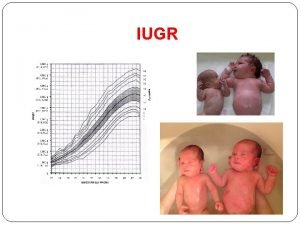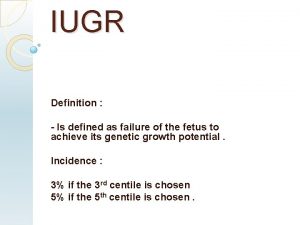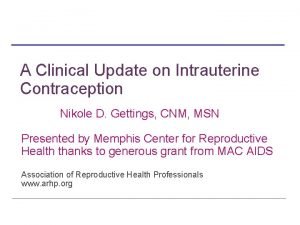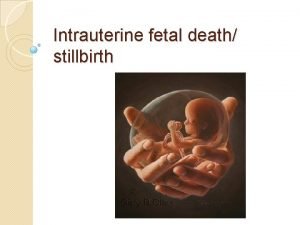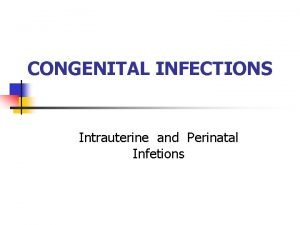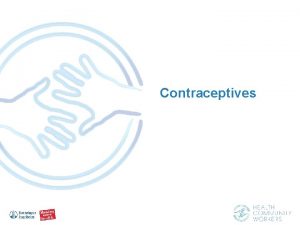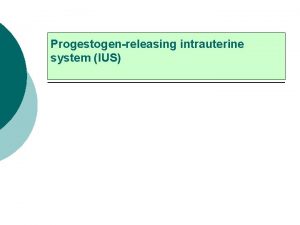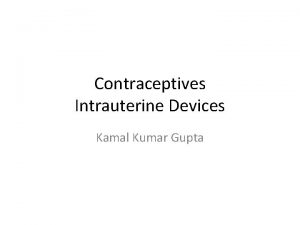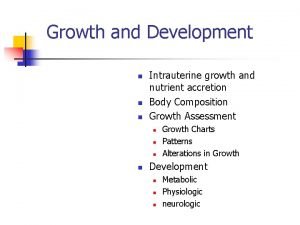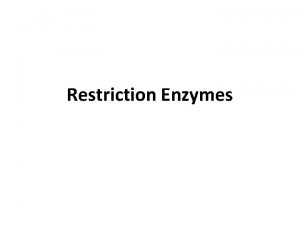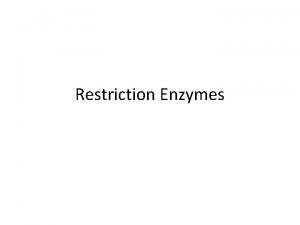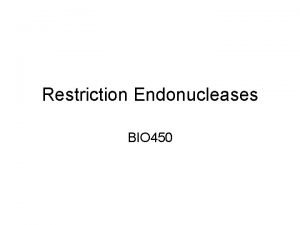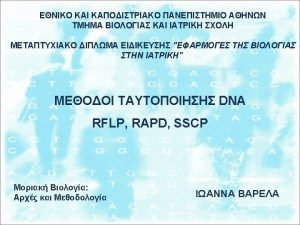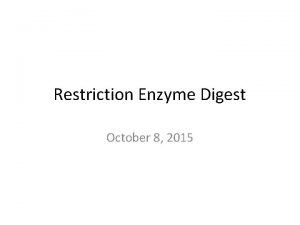Intrauterine Growth Restriction Eric H Dellinger MD Greenville































- Slides: 31

Intrauterine Growth Restriction Eric H. Dellinger, MD Greenville Hospital System


IUGR: Introduction • IUGR 2 nd leading contributor to PNM rate • PNM rate increased 6 -10 fold • PNM rate 8/1000 background: – 120/1000 for all IUGR – 60 -80/1000 when anomalies excluded

IUGR: Introduction • 40% of stillbirths have IUGR – 53% of preterm stillbirths – 26% of term stillbirths • Intrapartum asphyxia reported in up to 50% of IUGR fetuses • > 60% of IUGR fetuses with FHR tracing abnormalities have hypoxia/acidosis • Pardi, NEJM 328: 692, 1993

When is small, too small? Defining IUGR

IUGR: Definition • Birth weight < 10 th percentile used to define growth restriction at birth • Definition carried over to fetuses using ultrasound measurements (+/- 15%) • Using 10 th percentile, 70% will be constitutionally small (no increase risk) • Two SD = less than 3 rd percentile • AC < 2. 5 th percentile has 95% sensitivity

IUGR: PNM and EFW

Background Information

Normal Versus Abnormal

Normal Versus Abnormal < 10 th Percentile 70% Normal (Constitutional IUGR) 30% Abnormal (Pathological IUGR)

IUGR: Etiology Fetal / Placental Chromosomal / Genetic Twins Congenital malformation Infectious disease CMV Toxoplasmosis illness Rubella Placental pathology Previa Abruption Mosaiacism Infarction Maternal History of IUGR Hypertension Diabetes MSAFP increase APS Chronic Weight < 90% IBW Hemoglobinopathy Substance abuse Anemia/Hypoxia

Past History of IUGR • Prior history #1 risk factor for subsequent IUGR • 1 prior episode: 25% recurrence • 2 episodes: Fourfold increase • 1/3 population “at risk”: 2/3 IUGR babies • 2/3 population “low risk”: 1/3 of the IUGR babies, but most are constitutional

IUGR: Diagnosis • The Fundal Height Myth: – best from 20 -32 weeks: lightening – lag of 4 cm suspicious – Sensitivity of 27%, PPV of 18% • Fundal height of limited value – risk factors more predictive

IUGR: Fetal Measurements • Have you weighed a fetus lately? – EFW derived indirectly • “Normal” growth curves difficult to establish • PTL strongly associated with IUGR – BW derived charts inaccurate • U/S growth curves more accurate over preterm age ranges

IUGR: Fetal Growth Patterns When did you last watch a fetus grow?

Strategy

Strategy • Normal versus abnormal • Symmetric versus asymmetric • Fetal causes – Anomalies, arrhythmias, infection • • Placental problems Amniotic fluid Dopplers Fetal surveillance

HC/AC Ratios Weeks Ratio <32 > 1. 0 32 -34 ~ 1. 0 >34 < 1. 0 Asymmetric Symmetric HC preserved, ratio > 1. 0 HC, AC both small, ratio ~ 1. 0

IUGR: HC/AC Ratios Asymmetric Symmetric HC HC HC/AC AC

Asymmetric vs. Symmetric Asymmetric Symmetric Utereo-placental Constitutional Aneuploidy Infection

Fetal Causes • • Aneuploidy Anomalies Arrhythmias Infection

Aneuploidy

Anomalies

Arrhythmias

Infection

Placental Causes



Amniotic Fluid Volume


IUGR: Oligohydramnios • Initial harbinger of doom – IUGR, preeclampsia – may precede abnormal HC/AC • Fluid pocket of BPP: – >2 cm 6% IUGR – 1 -2 cm 20% IUGR – <1 cm 39% IUGR – also predicts intrapartum distress
 Symmetrical growth restriction causes
Symmetrical growth restriction causes Small for gestational age causes
Small for gestational age causes Jolynn dellinger
Jolynn dellinger Symmetrical growth restriction
Symmetrical growth restriction Iugr causes
Iugr causes Iugr
Iugr Intrauterine
Intrauterine Spalding sign
Spalding sign Metricure intrauterine
Metricure intrauterine Intrauterine device
Intrauterine device Hutchinson triad
Hutchinson triad Intrauterine device
Intrauterine device Barry esposito
Barry esposito Lockheed martin greenville sc address
Lockheed martin greenville sc address Greenville retinitis pigmentosa
Greenville retinitis pigmentosa 244 terminal rd greenville sc
244 terminal rd greenville sc Greenville bar cle
Greenville bar cle Grant woldum
Grant woldum Monroe doctrine political cartoon meaning
Monroe doctrine political cartoon meaning Greenville elementary logan utah
Greenville elementary logan utah Yellow cab greenville sc
Yellow cab greenville sc Greenville housing authority payment standards
Greenville housing authority payment standards South greenville recreation center
South greenville recreation center Ent greenville
Ent greenville Scavenger hunt greenville
Scavenger hunt greenville Intolerable acts
Intolerable acts Plant growth analysis
Plant growth analysis Difference between organic and inorganic growth
Difference between organic and inorganic growth Monocots vs eudicots
Monocots vs eudicots Chapter 35 plant structure growth and development
Chapter 35 plant structure growth and development Carothers equation
Carothers equation Geometric exponential growth
Geometric exponential growth
